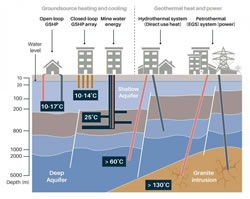- Details
- Hits: 4663
 March 2022: PDF to download from EGEC Geothermal [Click Here]
March 2022: PDF to download from EGEC Geothermal [Click Here]
The term ‘geothermal energy’ refers to any heat derived from the ground, from depths of a few metres to multiple kilometres beneath the Earth’s surface.
Low-grade heat stored in the shallow subsurface (<200 m) is largely derived from solar radiation that is absorbed by the ground and distributed via natural groundwater systems and artificial structures such as flooded coal mines. The ground acts as a solar battery and, for this heat, utilisation usually requires a heat pump. This energy is widely described as ‘ground-source energy’ or ‘shallow geothermal energy’.
There is no strict definition for ‘deep geothermal energy’, but the UK Government has adopted the term to refer to heat resources derived from depths of >500 m. The heat of the Earth increases with depth, a phenomenon described as the geothermal gradient. This heat is partly the primordial heat from when the Earth was formed and partly heat generated from within the Earth’s crust from the decay of mildly radioactive elements. This upward heat flux varies across the globe, but in the UK is around 27°C/km (Busby, 2014). Assuming an average annual air temperature of 12°C, this means that subsurface temperatures at 1000 m, 3000 m and 5000 m are around 39°C, 89°C and 139°C, respectively.
